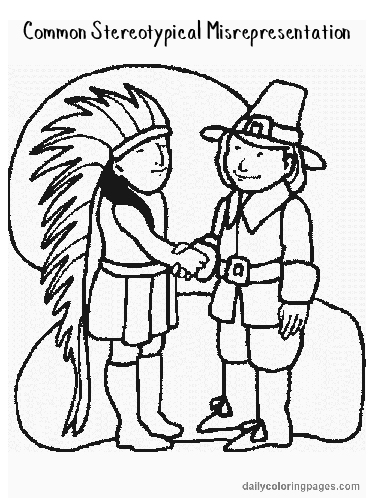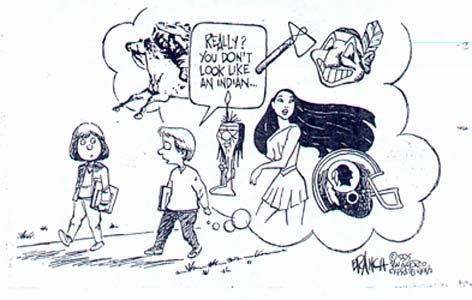We hope this will be a good start in correcting the vast amount of miseducation and especially in ridding ourselves of all types of prejudice, most importantly stereotyping, and we hope the information on these pages stimulate questions and thus create a renewed interest in history.
Stereotyping and Thanksgiving

The Pilgrims are stereotyped as badly as the Wampanoag. Pilgrim women and men are depicted wearing somber black clothes with big white collars and men with hats and silver buckles. This is historically and culturally incorrect. This manner of dress was a common for "Puritans". The Pilgrims were not Puritans, they were Separatists, and did not have a particular manner of dress other than the common clothing of the average person in England during the seventeenth century, which was rather colorful. Besides, the Puritans were not in Plymouth at the time of the first Thanksgiving. Their history begins much later.
Native images typical in the majority of Thanksgiving promotions and other media do not depict the Wampanoag. These images are usually depicting Plains Indians living in tipis with large eagle feather headdresses and are just as historically and culturally incorrect as the Pilgrim stereotype.
Stereotyping and American Indians
One of the major issues for Native People is stereotyping which keeps us invisible from the general public. We are usually not recognized unless we wear leather with fringe, adorn ourselves with feathers and have black hair, brown eyes and dark skin. A very common native comic is this one:

An additional note is that stereotyping affects all people. For instance, the Irish are far too frequently depicted as red haired people who drink beer, wear shamrocks and chase after rainbows. For the good of all, it is worth the effort to educate ourselves and stimulate enough interest to get us looking beyond the stereotype and into the reality of yesterday and today's world. As Lea and I continue to work on the Many Hoops around Thanksgiving website we will add more information on stereotyping.

This is a video specific to stereotyping of the Wampanoag people

Stereotypes for the Classroom
• Have the class draw how they think an "Indian" or Native person looks. Look at the completed drawings and ask the group what identifies those depicted as Native American. List the traits suggested by the class (i.e. feathers, arrows). This list can be a jumping-off point for a conversation about stereotypes, and where they originate.
• Ask the class where they got these ideas about Native people. Do they know a Native person who fits this description? How do they know it is a true depiction? How do you think a Native person would feel about this representation? This activity is excellent for beginning a curriculum, as it provides a good idea of how the class understands Native people. It can also be repeated at the end of the curriculum -- and the "before" and "after" drawings can be compared -- as an evaluation tool. The role plays exlained in  After 1620 can be used to address the stereotype of Native people as unjustly aggressive warriors.
After 1620 can be used to address the stereotype of Native people as unjustly aggressive warriors.
• Start collecting images of native people found in books, magazines, products etc.